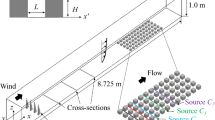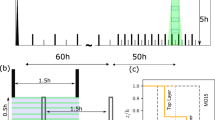Abstract
The effects of fetch on turbulent flow and pollutant dispersion within a canopy formed by regularly-spaced cubical objects is investigated using large-eddy simulation. Six tracer gases are simultaneously released from a ground-level continuous pollutant line source placed parallel to the spanwise axis at the first, second, third, fifth, seventh and tenth rows. Beyond the seventh row, the standard deviations of the fluctuations in the velocity components and the Reynolds shear stresses reach nearly equivalent states. Low-frequency turbulent flow is generated near the bottom surface around the first row and develops as the fetch increases. The turbulent flow eventually passes through the canopy at a near-constant interval. The mean concentration within the canopy reaches a near-constant value beyond the seventh row. In the first and second rows, narrow coherent structures frequently affect the pollutant escape from the top of the canopy. These structures increase in width as the fetch increases, and they mainly affect the removal of pollutants from the canopy.














Similar content being viewed by others
References
Antonopoulos-Domis M (1981) Large eddy simulation of a passive scalar in isotropic turbulence. J Fluid Mech 104:55–79
Belcher SE (2005) Mixing and transport in urban areas. Philos Trans R Soc A 363:2947–2968
Belcher SE, Jerram N, Hunt JCR (2003) Adjustment of a turbulent boundary layer to a canopy of roughness elements. J Fluid Mech 488:369–398
Boppana VBL, Xie ZT, Castro IP (2010) Large-eddy simulation of dispersion from surface sources in arrays of obstacles. Boundary-Layer Meteorol 135:433–454
Branford S, Coceal O, Thomas TG, Belcher SE (2011) Dispersion of a point-source release of a passive scalar through an urban-like array for different wind. Boundary-Layer Meteorol 139:367–394
Cai X-M, Barlow JF, Belcher SE (2008) Dispersion and transfer of passive scalars in and above street canyons—large-eddy simulations. Atmos Environ 42:5885–5895
Cheng WC, Liu C-H (2011) Large-eddy simulation of flow and pollutant transports in and above two-dimensional idealized street canyon. Boundary-Layer Meteorol 139:411–437
Cheng WC, Porté-Agel F (2015) Adjustment of turbulent boundary-layer flow to idealized urban surfaces: a large-eddy simulations study. Boundary-Layer Meteorol 155:249–270
Coceal O, Belcher SE (2004) A canopy model of mean winds through urban areas. Q J R Meteorol Soc 130:1349–1372
Coceal O, Thomas TG, Castro IP, Belcher SE (2006) Mean flow and turbulence statistics over groups of urban-like cubical obstacles. Boundary-Layer Meteorol 121:491–519
Coceal O, Thomas TG, Belcher SE (2007) Spatial variability of flow statistics within regular building arrays. Boundary-Layer Meteorol 125:537–552
Deardorff JW (1970) A numerical study of three-dimensional turbulent channel flow at large Reynolds numbers. J Fluid Mech 41:453–480
Garbero V, Salizzoni P, Soulhac L (2010) Experimental study of pollutant dispersion within a network of street. Boundary-Layer Meteorol 136:457–487
Hang J, Li Y, Sandberg M, Buccolieri R, Sabatino DS (2012) The influence of building height variability on pollutant dispersion and pedestrian ventilation in idealized high-rise urban areas. Build Environ 56:346–360
Hanna SR, Tehranian S, Carissimo B, Machdonald RW, Lohner R (2002) Comparisons of model simulations with observations of mean flow and turbulence within simple obstacle arrays. Atmos Environ 36:5067–5079
Inagaki A, Castillo MCL, Yamashita Y, Kanda M, Takimoto H (2012) Large-eddy simulation of coherent flow structures within a cubical canopy. Boundary-Layer Meteorol 142:207–222
Issa R (1986) Solution of implicitly discretized fluid flow equations by operator splitting. J Comput Phys 62:40–65
Kanda I, Yamao Y (2011) Velocity adjustment and passive scalar diffusion in and above an urban canopy in response to various approach flows. Boundary-Layer Meteorol 141:415–441
Kanda M, Moriwaki R, Kasamatsu F (2004) Large-eddy simulation of turbulent organized structures within and above explicitly resolved cube arrays. Boundary-Layer Meteorol 112:343–368
Kim J-J, Baik J-J (2004) A numerical study of the effects of ambient wind direction on flow and dispersion in urban street canyons using the RNG k-ε turbulence model. Atmos Environ 38:3039–3048
Kono T, Tamura T, Ashie Y (2010) Numerical investigations of mean winds within canopies of regularly arrayed cubical buildings under neutral stability conditions. Boundary-Layer Meteorol 134:131–155
Letzel M, Krane M, Raasch S (2008) High resolution urban large-eddy simulation studies from street canyon to neighborhood scale. Atmos Environ 42:8770–8784
Liu C-H, Barth MC (2002) Large-eddy simulation of flow and scalar transport in a modeled street canyon. J Appl Meteorol 41:660–673
Liu C-H, Barth MC, Leung DYC (2004) Large-eddy simulation of flow and pollutant transport in street canyons of different building-height-to-street-width ratios. J Appl Meteorol 43:1410–1424
Michioka T, Sato A (2012) Effect of incoming turbulent structure on pollutant removal from two-dimensional street canyon. Boundary-Layer Meteorol 145:469–484
Michioka T, Kurose R, Sada K, Makino H (2005) Direct numerical simulation of a particle-laden mixing layer with a chemical reaction. Int J Multiphase Flow 31:843–866
Michioka T, Sato A, Takimoto H, Kanda M (2011) Large-eddy simulation for the mechanism of pollutant removal from a two-dimensional street canyon. Boundary-Layer Meteorol 138:195–213
Michioka T, Takimoto H, Sato A (2014) Large-eddy simulation of pollutant removal from a three-dimensional street canyon. Boundary-Layer Meteorol 150:259–275
Michioka T, Takimoto H, Ono H, Sato A (2016) Effect of fetch on a mechanism for pollutant removal from a two-dimensional street canyon. Boundary-Layer Meteorol 160:185–199
Michioka T, Takimoto H, Ono H, Sato A (2017) Reynolds-number dependence of gas dispersion over a wavy wall. Boundary-Layer Meteorol 164:401–418
Momen M, Bou-Zeid E (2017) Mean and turbulence dynamics in unsteady Ekman boundary layers. J Fluid Mech 816:209–242
OpenFOAM (2012) OpenFOAM: The open source CFD toolbox. http://www.openfoam.com/
Schultz M, Schatzmann M, Leitl B (2005) Effect of roughness inhomogeneities on the development of the urban boundary layer. Int J Environ Pollut 25:105–117
Soulhac L, Garbero V, Salizzoni P, Mejean P, Perkins RJ (2009) Flow and dispersion in street intersections. Atmos Environ 43:2981–2996
Takimoto H, Sato A, Michioka T, Kanda M (2009) PIV measurements on the effects of fetch lengths and atmospheric stabilities on turbulent flow over building arrays. In: An international workshop on physical modeling of flow and dispersion phenomena, 24–26 August 2009, Phode-St-Genese, Belgium, F 5.1-F.5.8
Takimoto H, Sato A, Barlow JF, Moriwaki R, Inagaki A, Onomura S, Kanda M (2011) Particle image velocimetry measurements of turbulent flow within outdoor and indoor urban scale models and flushing motions in urban canopy layers. Boundary-Layer Meteorol 140:295–314
Uehara K, Murakami S, Oikawa S, Wakamatsu S (2000) Wind tunnel experiments on how thermal stratification affects flow in and above urban street canyons. Atmos Environ 34:1553–1562
Walton A, Cheng AYS (2002) Large-eddy simulation of pollution dispersion in an urban street canyon—part II: idealized canyon simulation. Atmos Environ 36:3615–3627
Yaghoobian N, Kleissl J, Paw UKT (2014) An improved three-dimensional simulation of the diurnally varying street-canyon flow. Boundary-Layer Meteorol 153:251–276
Acknowledgements
This research was supported by the Japan Society for the Promotion of Science (JSPS), KAKENHI (15K06343).
Author information
Authors and Affiliations
Corresponding author
Rights and permissions
About this article
Cite this article
Michioka, T., Takimoto, H., Ono, H. et al. Effects of Fetch on Turbulent Flow and Pollutant Dispersion Within a Cubical Canopy. Boundary-Layer Meteorol 168, 247–267 (2018). https://doi.org/10.1007/s10546-018-0339-5
Received:
Accepted:
Published:
Issue Date:
DOI: https://doi.org/10.1007/s10546-018-0339-5




